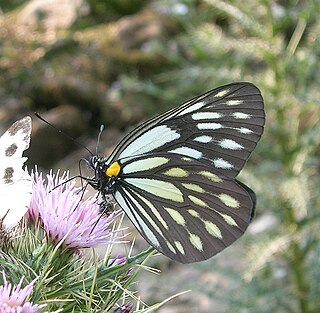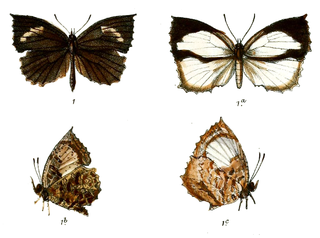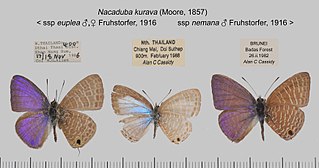
Symphaedra nais, also known as the baronet, is a species of Nymphalid butterfly found in South Asia. It was formerly included in the genus Euthalia but it is a sister to members of the genus Bassarona.

Graphium antiphates, the five-bar swordtail, is a species of papilionid butterfly found in South and Southeast Asia. The species was first described by Pieter Cramer in 1775.

Gomalia elma, also known as the marbled skipper or African marbled skipper, is a species of hesperiid butterfly. It is found in Africa and parts of Asia.

Graphium cloanthus, the glassy bluebottle, is a common, non-threatened tropical butterfly of the family Papilionidae.

Aporia agathon, the great blackvein, is a mid-sized butterfly of the family Pieridae, that is, the yellows and whites, which is found in Nepal, India, China and Southeast Asia.

Hebomoia glaucippe, the great orange-tip, is a butterfly belonging to the family Pieridae, that is the yellows and whites. It is found in the Indomalayan realm and Wallacea.

Miletus symethus, the great brownie, is a small butterfly found in India that belongs to the lycaenids or blues family. The species was first described by Pieter Cramer in 1777.

Allotinus drumila, the crenulate darkie, is a small butterfly found in India, Burma, Thailand, Laos, Vietnam, and Yunnan (China) that belongs to the lycaenids or blues family.

Jamides celeno, the common cerulean, is a small butterfly found in Indomalayan realm belonging to the lycaenids or blues family. The species was first described by Pieter Cramer in 1775.

Hypolimnas misippus, the Danaid eggfly, mimic, or diadem, is a widespread species of nymphalid butterfly. It is well known for polymorphism and mimicry. Males are blackish with distinctive white spots that are fringed in blue. Females are in multiple forms that include male-like forms while others closely resemble the toxic butterflies Danaus chrysippus and Danaus plexippus.

Dophla evelina, the red-spot duke, is a species of brush-footed butterfly found in Cambodia and South and Southeast Asia. Many subspecies are accepted. The species was first described by Caspar Stoll in 1790.

Curetis bulis, the bright sunbeam, is a species of butterfly belonging to the lycaenid family. It is found in Asia.

Nacaduba kurava, the transparent six-line blue, is a species of butterfly in the family Lycaenidae found in Asia and Australia. The species was first described by Frederic Moore in 1857.

Grammodes stolida, the geometrician, is a moth of the family Erebidae. The species was first described by Johan Christian Fabricius in 1775. It is found in Africa, southern Europe, most of Asia and Australia. It migrates to central and northern Europe as far north as England, Denmark and Finland.

Spilosoma fumida is a species of moth of the family Erebidae. It was described by Alfred Ernest Wileman in 1910. It is found in Taiwan.
Episcepsis gnomoides is a moth of the family Erebidae. It was described by William Schaus in 1910. It is found in Costa Rica.
Episcepsis lenaeus is a moth of the family Erebidae. It was described by Pieter Cramer in 1780. It is found from Mexico to the Guianas.
Episcepsis capysca is a moth of the family Erebidae. It was described by William Schaus in 1910. It is found in Costa Rica.
Episcepsis lamia is a moth of the family Erebidae. It was described by Arthur Gardiner Butler in 1877. It is found in the Amazon region, Guatemala and Costa Rica.

Episcepsis venata is a moth of the family Erebidae. It was described by Arthur Gardiner Butler in 1877. It is found in Mexico and the Amazon region.
















